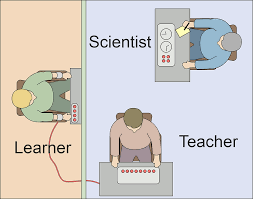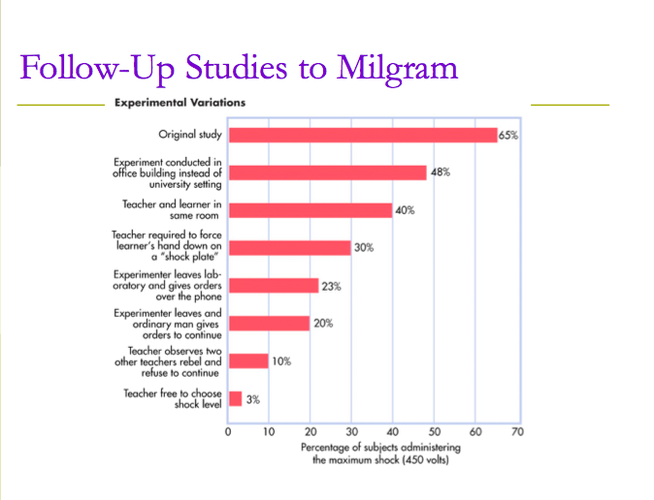Social Influence
1/30
Earn XP
Description and Tags
Name | Mastery | Learn | Test | Matching | Spaced |
|---|
No study sessions yet.
31 Terms
Lucas (2006)
Found that there was greater conformity to incorrect answers to mathematical problems when they were difficult than when they were easier
Shows that people conform when they don't know the answer (ISI)
Schultz (2008)
In the control, a door hanger informed guests of the environmental benefits of reusing towels.
In the experimental condition, added to this was the info "75% of guests choose to reuse their towels each day". In comparison to control, guests reduced their need for towels by 25%
↳ Shows that ppl conform to fit in (NSI)
Asch (1951)
Conducted experiments on conformity. 18 trials of judging line length; confederates gave wrong answer on 12 of the trials
Baseline findings :
On average, the genuine ppts agreed 32% of the time (75% conformed at least once)
Critical Ev:
Biased sample - all male ppts in the same age group
Judging line lengths is an artificial task
↳ low ecological validity so results cannot be generalised to other real life situations of conformity or other groups of ppl
Asch’s variations
1) Group size - Conformity increased with group size, but only up to a point. With 3 confederates, conformity rose to 31.8%, then levelled off.
2) Unanimity - Introduced a confederate who disagreed with the others. Conformity decreased to 5%, even when the dissenter disagreed with the ppt (use for social support - conformity)
3) Task difficulty - Made lines more similar in length. Conformity increased due to ISI
Zimbardo et al (1971)
Zimbardo's Stanford Prison Experiment
Procedure:
24 male college students randomly assigned as "prisoners" or "guards" in a simulated prison.
Guards given uniforms, sunglasses, and authority.
Prisoners wore smocks and were addressed by numbers.
Study planned for 2 weeks, ended after 6 days due to extreme behaviours.
Findings:
Guards: Became authoritarian, abusive, and dehumanizing.
Prisoners: Showed stress, depression, and passivity; some had emotional breakdowns.
Conclusion
Situational factors (roles and environment) can lead to extreme behaviours, overriding individual personality traits.
Zimbardo et al (1975) Ev : Control
Control over key variables, eg. when selecting chose emotionally stable individuals + randomly assigned roles
↳ increases internal validity of study, can be confident in drawing conclusions about influence on roles of conformity
Zimbardo et al (1975) Ev : Lack of realism
Banuazizi & Mohavedi (1975) argued ppts were merely play acting rather than conforming
Behaviours based on stereotypes of how prisoners and guards are supposed to behave
↳ Counterpoint - McDermott (2019) argues they did behave as if it was real to them, eg. 90% of their conversations were about prison life, suggesting it did replicate social roles giving high internal validity
Zimbardo et al (1975) Ev : Exaggerates power of roles
Only 1/3 of the guards actually behaved in a brutal manner; another 1/3 tried to apply the rules fairly; the rest actively tried to help and support the prisoners
This suggests that Zimbardo overstated his view that SPE ppts were conforming to social roles and minimised influence of dispositional factors
Zimbardo et al (1975) Ev : Alternative explanation - Reicher & Haslam (2006)
Zimbardo suggested conforming to social roles comes naturally and easily
However, Reicher & Haslam (2006) criticise Zimbardo’s explanation because it does not account for the behaviour of the non-brutal guards
They used social identity theory (SIT) instead to argue the guards had to actively identify with their social roles to act as they did
Milgram (1963)
Method:
Participants were told it was a study on punishment and memory.
They were instructed to deliver increasing electric shocks to a "learner" (a confederate) when they answered incorrectly.
Findings:
65% of participants delivered the maximum shock (450 volts), despite the learner’s apparent distress.
Many ppts showed signs of stress but still obeyed.
Conclusion: Ordinary people are likely to follow orders from an authority figure, even to the extent of harming others.

Milgram’s variations

proximity - 40%
touch proximity - 30%
instructions over phone - 20.5%
Location - run down office block - 47.5%
(use rebelling peers (10%) for social support - obedience)
Milgram (1963) Ev: Mendel (1998)
Argues this offers an excuse for bad behaviour
Offensive to Holocaust survivors as it argues Nazis were simply following orders and were victims themselves of situational factors beyond their control
Milgram (1963) Ev: Orne & Holland
Criticised original study, felt many ppts worked out procedure was faked
Also, conducted in an artificial setting (laboratory) - loss of external validity
Bickman (1974) - Power of uniform
3 male researchers gave orders to 153 randomly selected pedestrians, while dressed in: suit and tie, milkman’s uniform, and guard’s uniform
Guard was obeyed by 76%, milkman 47% and pedestrian 30%
Suggests people more likely to obey when instructed by someone wearing uniform as it infers a sense of legitimate authority and power
Bushman (1988)
Replicated Bickman’s study using a female authority figure
Police styled uniform obeyed by 72%, businesswoman 48% and beggar 52%
Sheriden & King (1972)
Students trained a puppy to learn a discrimination task by punishing it with increasing electric shocks
Ppts could see and hear squeals; an odourless anaesthetic was also released, causing it to fall asleep
75% delivered maximum shock: 54% male, 100% female
↳ Ev - Supports validity for Milgram as this time all shocks were real
Hofling et al (1966)
22 nurses received telephone calls to give an OD of ‘Astroten’ (a made-up drug), without any written authorisation
21 out of 22 nurses complied without hesitation (11 said they had not noticed the dose)
Ev:
Higher ecological validity than Milgram as they were in their natural environment, also given more realistic instructions.
Rank & Jacobson (1977)
Replicated Hofling’s study
However instruction was to deliver Valium at 3 times the recommended level
Instructions came from a real, known doctor, also nurses able to consult with other nurses before proceeding
Only 2 out of 18 prepared the medication as requested
Le Jeu de la Mort (The Game of Death) (2010)
Ppts paid to give (fake) electric shocks when ordered by the presenter to other ppts, who were in fact actors in front of the studio audience
Confirmation of Milgram’s results: 80% delivered maximum shock of 460V to an apparently unconscious man
Milgram and Elms (1966)
Obtained a sample of 20 obedient ppts who administered the full 450V, and 20 disobedient ppts
They completed several personality questionnaires, including Adorno’s F scale to measure their levels of authoritarian personality
Found that obedient ppts scored higher on the F scale
Greenstein (1969)
Describes Adorno’s F scale as a ‘comedy of methodological errors’
Eg. if they ticked the same line of boxes (agree) throughout they would score highly - only measures ppl’s tendency to agree to everything
Adorno’s research also prone to researcher effects as they were aware of ppt’s score - may have asked leading qs during the interview
Albrecht et al (2006)
Evaluated Teen Fresh Start USA (8 week programme helping pregnant 14-19 yr olds to resist peer pressure to smoke); social support was provided by a slightly older mentor - a ‘buddy’.
At the end of the programme adolescents who had a buddy were significantly less likely to smoke than a control group who didn’t.
Gamson et al (1982)
Ppts told to produce evidence to help an oil company run a ‘smear campaign’
29 out of 33 groups (88%) rebelled against their orders - shows peer support can lead to disobedience by undermining legitimacy of authority figure
Allen & Levine (1971)
In Asch-type task, when dissenter was someone with apparently good eyesight, 64% refused to conform
When there was no support at all only 3% resisted
However, it also showed that social support doesn’t always help - when they had obviously poor eyesight resistance was only 3%
Holland (1967)
Replicated Milgram’s baseline study and measured whether ppts were internals or externals
Found that 37% of internals did not continue to the highest shock level, whereas 23% of externals did not continue
Ev:
Resistance is at least partly related to LOC, which increases its validity as an explanation of obedience
Twenge et al (2004)
Analysed data from American locus of control studies conducted over a 40 year period (from 1960 to 2002)
The data showed that, over this time span, ppl become more resistant to obedience but also more external - challenging link between LOC and resistance
Rotter (1982)
Points out that LOC is not necessarily the most important factor in determining whether someone resists social influence
Depends on whether you have conformed or obeyed in a specific situation in the past
Moscovici et al (1969)
172 female ppts placed in groups with 4 ppts and 2 confederates
Shown 36 slides which were clearly different shades of blue, then asked to state the colour of each slide
In condition one the confederates were consistent in answering green, in condition two they answered green 24 times and blue 12 times (inconsistent)
In condition one, found that consistent minority had effect on the majority (8.42%) compared to inconsistent minority (only 1.25%); a third (32%) of all ppts judged the slide to be green at least once. In a third control group with no confederates, ppts got the answer wrong on only 0.25% of trials
Nemeth (1986)
Ppts in groups of 4 had to agree on the amount of compensation they would give to a victim of a ski-lift accident
One ppt in each group was a confederate, two conditions: 1) when the minority argued for a low rate of compensation and refused to change his position (inflexible); 2) same rate but compromised by offering a slightly higher rate of compensation (flexible).
Found that in inflexible condition, the minority had little or no effect on the majority, however in flexible, much more likely to compromise and change view
Wendy Wood et al (1994)
Carried out meta analysis of almost 100 similar studies
Found that minorities who was seen as being consistent were most influential
Robin Martin et al (2003)
Presented message about a viewpoint, ppts heard minority or majority agree, then exposed to a conflicting viewpoint and their attitudes measured again
Ppl less willing to change their opinion if they had listened to a minority compared to a majority group